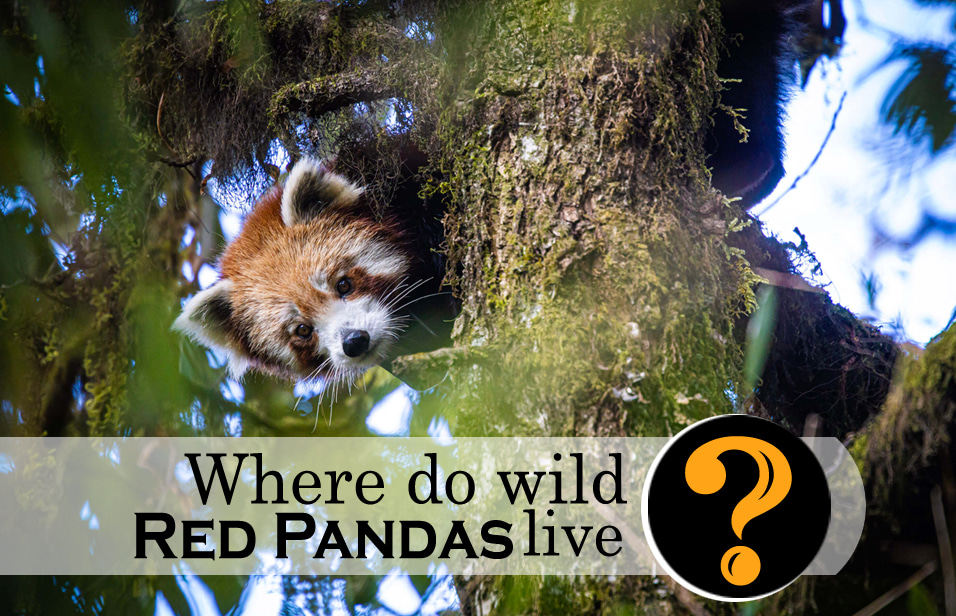Wild Red Panda –
Red Panda (Ailurus fulgens), is also known as the Lesser Panda, Red cat-bear, Panda, or red Bear-cat, reddish-brown, long-tailed, raccoon-like mammal.
Their body is covered with thick fur and is about the size of a large domestic cat.
Their diet consists mainly of Bamboo and also other vegetables, fruits, eggs, birds, and insects.
Red pandas are usually found in the mountain forests of the Himalayas and adjacent areas of Eastern Asia.
The special semi-retractable claws provide them to move freely from one branch to another and thus, they usually spend most of their time in trees.
Their limbs and belly area are black and they have distinct marks of white color on the sides of the eyes and heads. Their fuzzy tails help them to balance as they travel across branches.
The Red panda in wild is not at all any relative of the Giant panda, they are categorized as the sole member of the family Ailuridae.
Another interesting physical characteristic is its bushy tail, the long tail does not only provide the balance but also acts as a blanket to keep them warm from cold winters.
Red pandas are quite lazy and inactive during the day and they are solitary animals, mainly active from dusk to dawn.
Habitation of Red Panda –
The habitat of Red pandas consists of mixed broadleaf forests, evergreen forests, deciduous and coniferous forests with Bamboo covers.
These animals live between 2,200 and 4,800 m altitudes, settling in areas of moderate temperature between 10 and 25°C with little annual changes.
A red panda usually chooses their habitat close to some water bodies and the types of Vegetation generally are strong predictors of habitat use.
Although, the conditions of the Red Pandas’ habitats vary greatly. Like in Phrumsengla National Park, the habitats near water bodies, for example, were not a significant predictor of the presence of Red Pandas.
The Scenario of the world –
Sadly, since 2008, the name of the Red pandas was added as endangered on the IUCN Red List as their strength is about 12,000 individuals, with a decreasing scenario.
Now the species are using only half of the total area of the potential habitat of 142,000 km 2 (55,000 sq. mi).
The population of Red Panda in wild in India is about 5000 to 6000 which makes it the second-largest population after China (around 6000-7000 individuals). In the forests of Nepal too, there is a strength of about 317-582 pandas though there is no estimation of the number of pandas inhabiting Bhutan and Myanmar.
Where is Red Panda found in the wild?
From the sources of the WWF, about 50% of the concentration of Red panda is in the Eastern Himalayas.
Deforestation has led to the decline in their populations across its natural range, which continues to India, Nepal, Bhutan, and the northern mountains of Myanmar and southern China.
Wild Red Panda habitat in India –
Red panda tours helping you to see these animals in the country where nature resides- India.
Red pandas are found in quite a several places in India.
They are found in Singalila National Park, Darjeeling district of West Bengal, Sikkim, western Arunachal Pradesh, and parts of Meghalaya and it is the state animal of Sikkim.
The red panda has the highest legal protection with some other threatened species too under Schedule I of the Indian Wildlife (Protection) Act,1972, and also as they are listed in the IUCN Red List of Threatened Species.
If we notice the distribution range of Red Pandas then we may observe that it’s not continuous. This non-continuous population inhabits the Meghalaya Plateau of North-eastern India. The Red pandas may also live in South-west Tibet and northern Arunachal Pradesh but this thing has not been documented yet.
In 1992, Singalila Wildlife Sanctuary (SNP) belonging to the eastern Himalayas in Darjeeling, West Bengal, was proclaimed as a national park.
The park encompasses the Singalila Ridge, a mountain ridge that covers the area from West Bengal to Sikkim in the Himalayas. It was declared a major Red Panda habitat for red pandas in 1994. Towards the west, stands the frangible, open boundary with Nepal.
Small-scale community coursing in Singalila National Park, disappeared after restrictions, on breaking into the forest and designated park area, were procured in the rouse of India’s 1972 Wildlife Protection Act. This impacted the encouragement of the community to depart from villages for better possibilities. People who chose to stay had to look for alternative ways of earning money.
Wild Red Panda in Nepal –
There were traces of red pandas in Nepal’s Dhorpatan Hunting Reserve, in a survey back in the 1970s.
In spring 2007 their existence was established when four red pandas were espied at elevations ranging from 3,220 to 3,610 m (10,560 to 11,840 ft.).
The Rara National Park is its westernmost dispersal. In 2018, red pandas were traced at elevations of 3,150–3,650 m (10,330–11,980 ft.) in Nepal’s Lampung District.
Despite high protection provided in Nepal, the red panda remains highly endangered. Many Red panda sanctuary like Nepal’s Langtang National Park, Annapurna Conservation Area, Sagarmatha National Park, Manaslu Conservation Area, Makalu Barun National Park, and Kanchenjunga Conservation Area allows a Red panda tour.
Approximately 38% of the total potential red panda habitat is in Nepal. People found guilty of killing, buying, or selling red pandas face a fine of up to $1,000 is charged if any person is caught guilty of killing, buying, or selling red pandas. Even they might have to suffer almost 10 years in jail.
Red Panda in China –
Red Panda in China – As estimated 6,000 – 7,000 red pandas are remaining in China, in the wild. In recent times, rapid population downturns have been divulged for the species in China (40% decline over the last 50 years) which is quite analogous to the rates of downswing that has been spotted across the range of species.
The population of the red panda is more extensive and steady in Sichuan Province compared to that of the Yunnan population, propounding a southward expansion from Sichuan into Yunnan in the Holocene. The red panda has become eradicated from the Chinese provinces of Guizhou, Gansu, Shaanxi, and Qinghai. More than 75% of potential Red panda habitat contravene outside protected areas.
Red Panda Expedition in Singalila & Wild Nepal –
Red Panda Expedition exclusively takes you off the well-trodden track to Singalila National Park & Wild Nepal, located in a spectacular area in the foothills of the Himalayas.
Endangered red pandas can be tracked through peaceful montane forests and involved in important conservation work if you join a team of researchers. Out of the bustling cities of India while heading towards the worn paths to the tranquil wilderness of the Himalayan foothills, can be exclusively found in the safari to Singalila National Park.
Red panda Safari – In search of Fireballs of Himalayas also fulfill your birding photographic journey, because Singalila is one of the best parks for Himlayan Birds. While you stay in a traditional Nepali-style sojourn overlooking an alpine valley, you will be accompanied by a team of researchers as you track the elusive red pandas along meandering forest pathways.
The parks montane forests are birding heaven and are home to over 300 bird species, as well as other wildlife such as the Himalayan black bear, Indian pangolin, and clouded leopard.
Threats for Red Panda –
Red pandas are magnificent climbers and mostly forage on trees. Starting from bamboo to berries they feed on everything that is why deforestation and fragmentation of their natural habitat is one of the biggest menaces to them.
The next biggest threat for them is poaching, which has left only 14,500-15,000 individuals in the wild.
Indian Scientists are setting up DNA databases for these furry mammals and also reporting alerts of “serious threats ”to the Red pandas.
The Red pandas are hunted for their fur, meat and also they are valuable in the exotic pet business.
Earlier in this year, wildlife trade network TRAFFIC and the conservation NGO provided a new report with the title- “Of Back in this year, the conservation NGO and wildlife trade monitor network TRAFFIC issued a new report, titled- “Assessment Of Illegal Trade-related Threats To Red Panda in India and Selected Neighboring Range Countries.”




